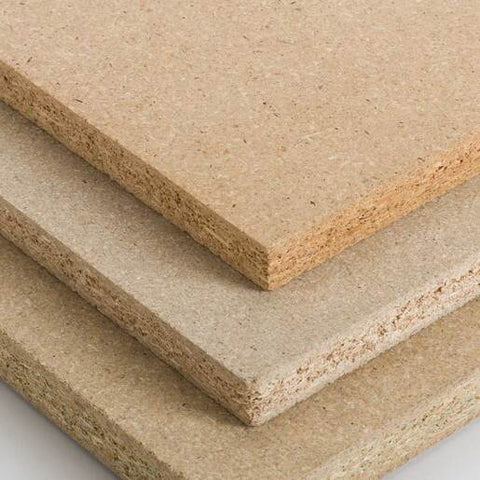Solid Wood vs Wood Veneer Furniture
Solid Wood vs. Wood Veneer Furniture
There are two main types of wood furniture: solid wood and wood veneers. While solid wood furniture is crafted completely out of solid wood, wood veneer furniture consists of a thin layer of wood that is attached to an inner panel or panels (usually fibreboard or particleboard). It is a common misconception that solid wood furniture is of higher quality than wood veneers; each has their place in furniture building when used properly. For furniture such as tables and chairs, solid wood is always best (if built correctly). In some instances, such as cabinetry, veneer furniture will outperform solid wood furniture in longevity, affordability, manageability and more. Here, we’ve laid out the differences between them.

pictured: solid wood bed frame by Timberware
What is wood veneer?
Wood veneer is a thin slice of natural wood that is attached, through gluing or pressing, onto a panel of fibreboard (MDF or HDF), particleboard or plycore. Particleboard is the most common and cost effective, but having a plycore layer in the centre is the best and most durable option.

pictured: wood veneer on fibreboard
Particleboard is made by mixing many bits of wood, sawdust and adhesive together and pressing it under extreme pressure into a flat panel. Particleboard on its own, is not a desirable finish for furniture, but with a veneer slice of a solid wood it has a much better appearance.

pictured: particle board
Fibreboard or MDF is made in a similar fashion by pressing glued wood fibres together into flat panels. MDF has a much smoother surface than particleboard, as it is made with much smaller fibres. Because of its smooth surface, it is a well suited material for paint finishes.

pictured: fibreboard
Plycore is made out of many thin wood layers (a less expensive wood than the surface veneer) glued together in an alternating grain pattern. The panel is still all wood, yet by alternating the grain direction of each layer, the panel is much more dimensionally stable than solid wood as it isn’t susceptible to expansion and contraction caused by atmospheric pressure. It is also more affordable than solid wood because is uses a less desirable wood in the centre, with the nice, sought after wood at the surface.

pictured: plycore
In furniture, wood veneers give the appearance of an all-wood piece, when in reality only the surface is taken from natural wood.
Advantages: Wood veneer pieces use a minimal amount of natural wood, making them more affordable. Wood veneers are also less prone to movement which can cause splitting, warping and fit problems that can come from an all-wood design.
Disadvantages: Wood veneers, when attached to fibreboard or particleboard, aren’t as heavy or durable as natural wood boards; if these wood veneers are not coated with a good surface finish, it is easy for liquids to be absorbed through the wood. Unlike solid wood, once damaged, wood veneers can be difficult or costly to repair. Plycore can be as strong or even stronger than solid wood, but still leaves the thin surface veneer susceptible to damage.
Best for: Cabinet boxes, door panels, back panels, shelving or for furniture pieces where budget is of higher importance than longevity.

pictured: solid black walnut
What is solid wood furniture?
Solid wood furniture is furniture made completely from natural wood except any areas of upholstery, metal fixtures, hardware, etc. Solid wood is the best option as far as durability and natural beauty. Solid wood comes in two main varieties: hardwood and softwood. While hardwood is denser and less prone to damage than softwood, both varieties are more durable than veneers. Depending on the craftsmanship of the piece, solid wood furniture can last for generations. A good craftsman will consider the type and quality of finish, cut (plain sawn, rift sawn, quarter sawn), design, hardware and other factors that go into the construction of quality furniture.
Advantages: Strength, longevity and character. Solid wood is easier to repair, as most forms of damage can be fixed with sanding and refinishing. While solid hardwoods will outperform veneers in terms of durability, character and strength, some softer woods such as cedar and pine are still a sought after option due to their susceptibility to distress, patina and other rustic signs of aging.
Disadvantages: Atmospheric pressure can cause natural wood to expand, leading to cracks, splits and warping. While a good craftsman knows how to design furniture with systems to prevent such from happening, wood movement must always be considered.
Best for: Tabletops, chairs and benches, doors and door frames. Those looking for durability, minimal maintenance and an all-natural aesthetic.
Benefits of Solid Wood
- It’s natural and sustainable. There are 318 billion trees in Canada! In Ontario, for every tree harvested, 3 take root.
- Solid wood is just that – wood. It’s not made of MDF or particleboard or ‘mysterious’ materials. When you purchase a solid wood piece, you know exactly what you’re getting.
- It’s durable. Solid wood is the best option for furniture that needs strength and durability.
- It’s unique. One solid wood piece will look different from another, thanks to the fact that in nature, no two grain patterns are alike. Swirls, circles, lines and spots appear in all shapes and sizes; as a result, choosing a coffee table or desk made of solid wood will be sure to add one-of-a-kind appeal to your home.
How to Tell the Difference Between Solid Wood and Veneer
- Look for end grain. If a furniture has edge grain on all sides of it, then it is veneer with edgebanding.
- Weigh it, or lift it up. If it is solid wood, the piece will feel heavy or be difficult to move. If it’s veneer, it will feel lighter.
- Feel for texture. In open grain wood species such as Ash, Oak and Walnut you will feel ridges and raising of natural grain. If the surface is completely smooth to the touch and is labelled as one of these wood species, it is likely veneer.
- Look for discrepancies in the grain. If you notice that the surface of the piece has the same grain pattern repeating, chances are it’s veneer. If, however, you don’t see any remarkable patterns, knots or symmetrical sides, chances are it’s solid wood.

Laminate vs. Veneer
Laminate is not wood, veneer is wood. The difference between the two is that laminate is a material other than wood (usually plastic) with a coating sometimes made to look like wood, while veneer is an actual thin slice of wood that is pressed onto the surface of a furniture piece. A common laminate surface is white melamine, however laminates can often be made to look like wood species by printing a photo of wood texture onto the plastic surface. If you feel the surface, you should be able to tell that it isn't wood. It will have a smooth plastic feel, rather than the warmth and texture of real wood.

pictured: laminate
Types of Wood Veneer
Technically, the types of wood veneer are the same as the types of wood – since veneer is simply a thinly sliced piece of wood. There are, however, types that are commonly seen in furniture and which you will probably encounter more often than others. These include:
- Walnut veneer
- Ash veneer
- Red Oak veneer
- White Oak veneer
- Birch veneer
- Acacia veneer
- Beech veneer

pictured: red oak veneer by Timberware
Can You Stain Wood Veneer?
Yes, if the veneer is unfinished and untreated, you can stain it in many different colours.
Can you stain Solid Wood?
Most definitely! We do, however, try to steer customers away from staining solid wood pieces simply because we prefer to let the natural beauty of the wood speak for itself. If you want a dark piece of furniture, use the natural tone of Black Walnut, Rosewood or Ebony to your advantage. If you prefer something light, choose Maple, Ash or Oak! If you are dead set on a certain species and prefer it to be lighter or darker, we recommend using a tinted oil over using a stain.
